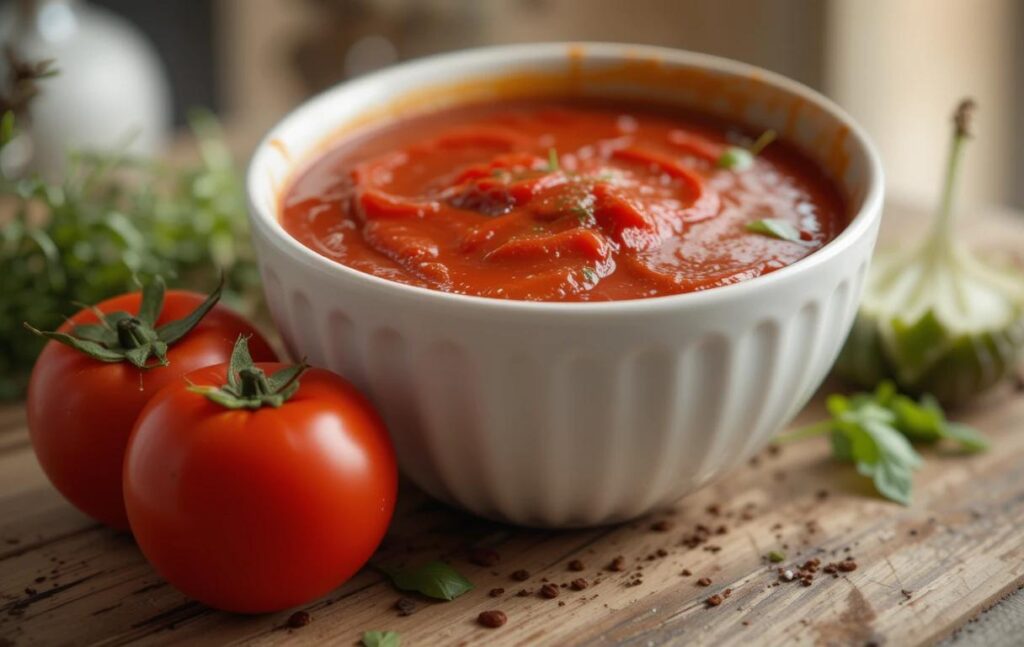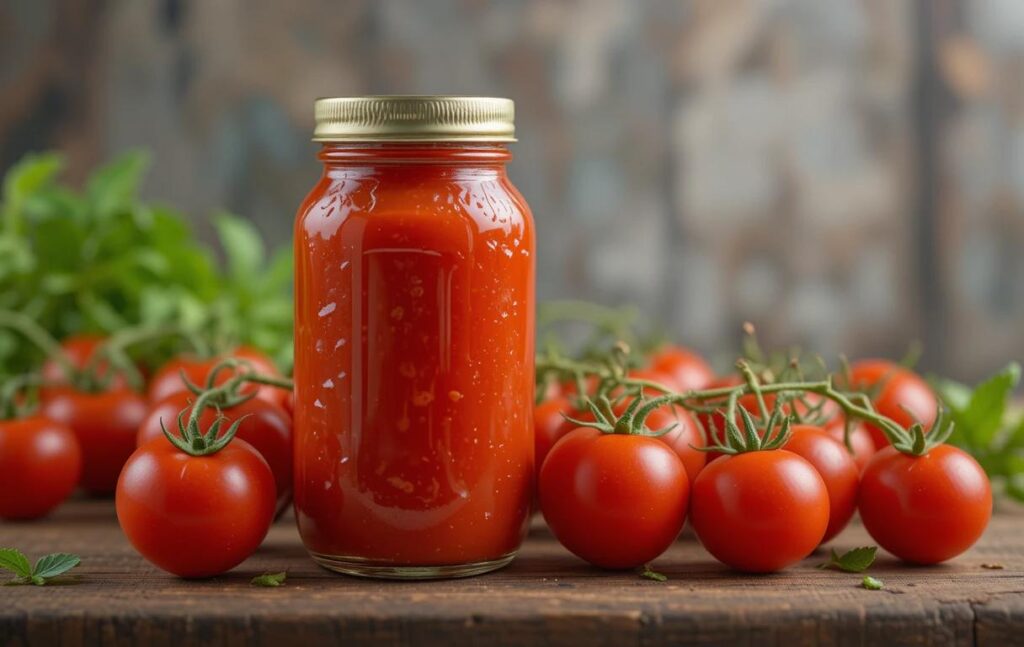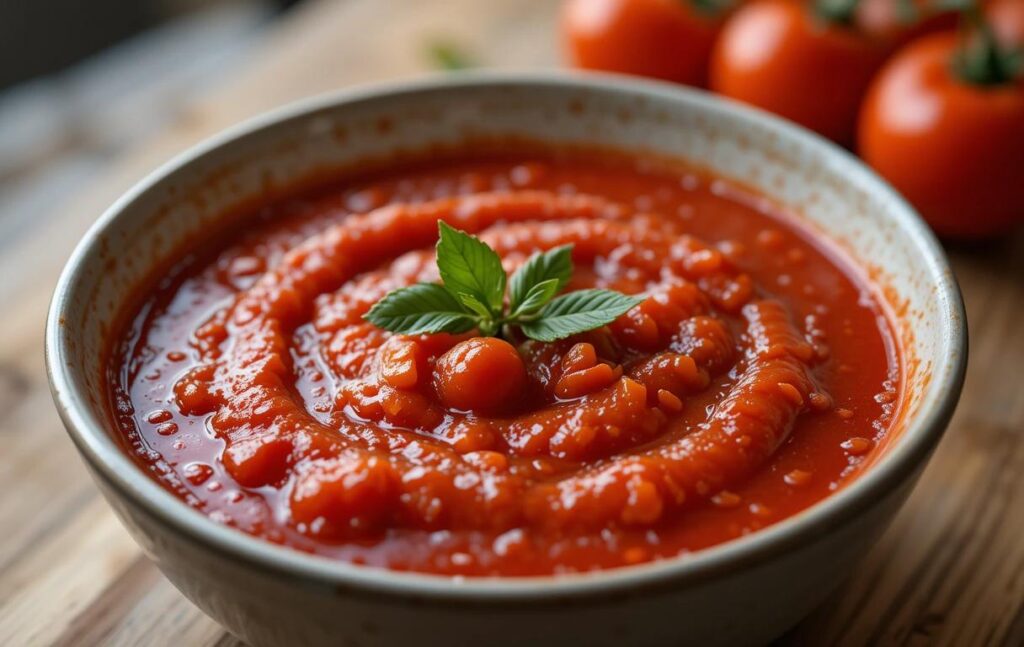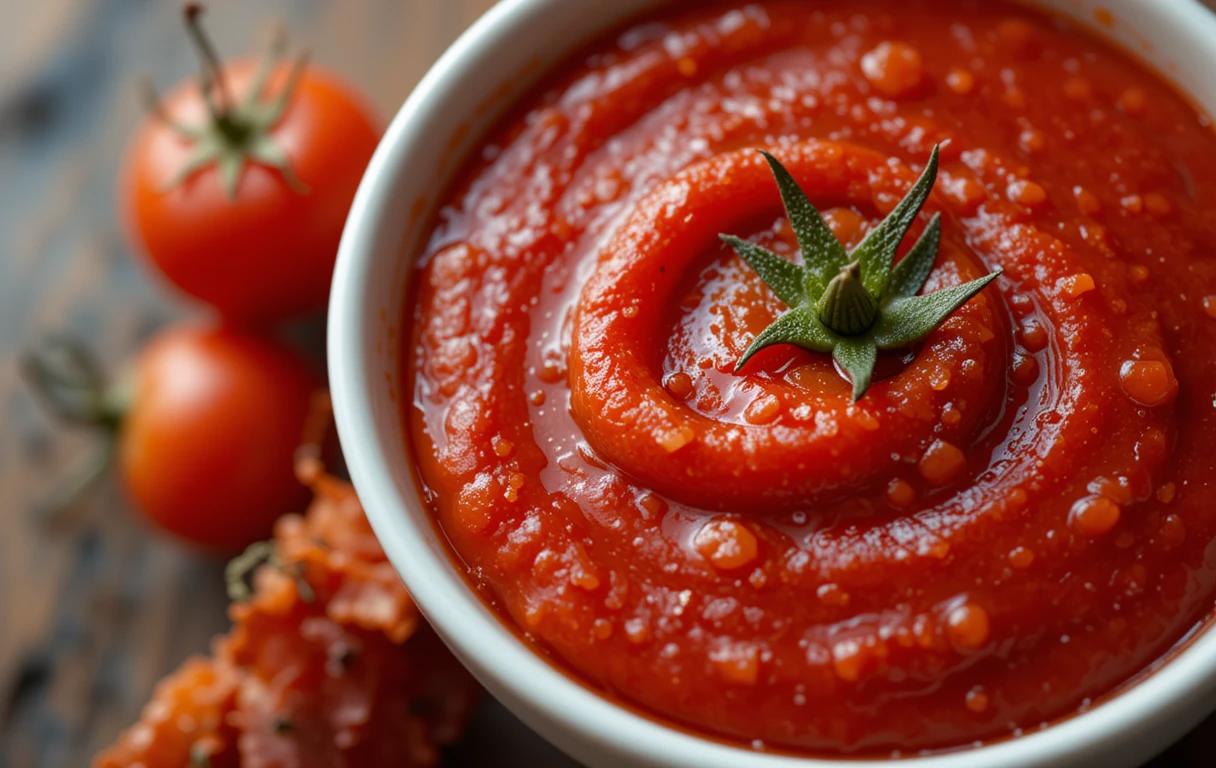Tomato gravy is a versatile and flavorful sauce that is a staple in many cuisines around the world. Made primarily from ripe tomatoes, it serves as a base for countless dishes, ranging from pasta sauces and curries to soups and stews. Its rich taste and vibrant red color make it a popular choice for enhancing the flavor and appearance of various meals.
The preparation of tomato gravy typically involves sautéing onions, garlic, and spices, to which pureed or chopped tomatoes are added. Depending on the regional cuisine, additional ingredients like herbs, cream, or meat stock may be included to deepen the flavor. For example, in Italian cooking, tomato gravy may feature basil and oregano, while in Indian cuisine, it is often enriched with ginger, chili, and a blend of aromatic spices.
One of the key attributes of tomato gravy is its adaptability. It can be made thick and robust to accompany hearty dishes, or light and tangy for a refreshing complement to lighter fare. Its nutritional benefits, including being a good source of vitamins A and C, potassium, and antioxidants like lycopene, further enhance its appeal.
Whether used as a standalone dish or as a base for more complex recipes, tomato gravy is a culinary essential that adds depth, warmth, and a burst of flavor to any meal.
Brief Overview of Tomato Gravy
Tomato gravy is a savory sauce made from tomatoes, often blended with onions, garlic, and a variety of spices or herbs. Known for its vibrant color, tangy flavor, and smooth texture, it serves as a versatile component in global cuisines. Whether served as a side dish, a topping, or a base for stews and curries, tomato gravy is celebrated for its ability to enhance the taste and appeal of countless recipes.
Cultural and Culinary Significance
Tomato gravy holds a prominent place in culinary traditions across the world, reflecting regional tastes and customs. In Italian cuisine, it forms the foundation of classic pasta sauces, enriched with olive oil, basil, and oregano. Indian cooking incorporates tomato gravy as a base for flavorful curries, blending it with spices like turmeric, cumin, and coriander. In Southern American cuisine, tomato gravy is a comfort food, often served with biscuits or rice.
Culturally, tomato gravy is a symbol of adaptability and resourcefulness. It transforms simple ingredients into rich, satisfying dishes, making it an essential part of everyday meals and festive occasions alike. Its global reach showcases the universal appeal of tomatoes, highlighting the ways in which different cultures have embraced and adapted this ingredient to suit their palates and traditions.
Tomato gravy is more than just a sauce—it is a testament to culinary creativity and the shared love for flavorful, nourishing food.
The Origins of Tomato Gravy
Historical Roots

Tomato gravy traces its origins to the introduction of tomatoes as a cultivated crop in various regions. Native to South America, tomatoes were first domesticated by the Aztecs and later introduced to Europe by Spanish explorers in the 16th century. Initially met with skepticism, tomatoes gradually gained acceptance and became a staple in Mediterranean cooking, particularly in Italy and Spain.
In the Americas, tomatoes became integral to Southern cooking, influenced by indigenous, African, and European culinary traditions. The evolution of tomato gravy reflects the adaptation of this versatile fruit in diverse culinary practices, combining local ingredients and cooking techniques to create a rich, flavorful sauce.
Regional Variations
Southern U.S. Tomato Gravy
In the Southern United States, tomato gravy emerged as a comfort food, deeply rooted in rural and agrarian lifestyles. Made with simple ingredients such as tomatoes, flour, and fat (like bacon drippings or butter), it became a frugal yet flavorful addition to meals. Often served over biscuits, rice, or grits, it reflects the resourcefulness of Southern cooks who turned basic pantry items into hearty dishes.
Global Influences
Tomato gravy has taken on unique forms in different parts of the world, influenced by regional ingredients and culinary traditions:
- Italian Cuisine: Known as “sugo di pomodoro,” Italian tomato gravy features garlic, olive oil, and herbs like basil. It serves as the base for pasta sauces, pizzas, and many other dishes.
- Indian Curries: In India, tomato-based gravies are enriched with a blend of spices such as turmeric, chili, and garam masala. These gravies serve as the foundation for dishes like butter chicken and paneer masala.
- Mexican Salsas: While not a traditional “gravy,” Mexican tomato sauces, such as salsa roja, share similarities with tomato gravy and are used to enhance tacos, enchiladas, and other dishes.
- Middle Eastern Shakshuka: This dish features a spiced tomato gravy as a base for poaching eggs, often seasoned with cumin, paprika, and chili.
Ingredients for Perfect Tomato Gravy
Essential Ingredients
To create a rich and flavorful tomato gravy, the following ingredients are essential:
- Fresh Tomatoes: The star ingredient, tomatoes provide the base flavor. Use ripe, red tomatoes for the best taste and texture.
- Onions: Adds sweetness and depth to the gravy, balancing the tanginess of the tomatoes.
- Garlic: Imparts a savory, aromatic quality that enhances the overall flavor.
- Cooking Fat: Options like olive oil, butter, or bacon drippings are commonly used to sauté the ingredients and create a silky texture.
- Salt and Pepper: Fundamental seasonings that highlight the natural flavors of the ingredients.
- Stock or Water: Adds moisture and helps achieve the desired consistency.
Optional Flavor Enhancers
To elevate the taste of tomato gravy, consider incorporating these optional ingredients:
- Herbs: Fresh or dried basil, oregano, parsley, or thyme for added aroma and complexity.
- Spices: Cumin, paprika, red chili flakes, or garam masala for regional flavor variations.
- Cream or Milk: Creates a rich, velvety texture, particularly in Southern-style or creamy tomato gravies.
- Sugar: A pinch of sugar can balance the acidity of the tomatoes.
- Wine or Vinegar: Adds a tangy depth, commonly used in Mediterranean-style gravies.
- Cheese: Parmesan or cheddar can be incorporated for a cheesy, indulgent twist.
- Protein: Ground meat, bacon, or sausage can make the gravy heartier and more robust.
Tips for Selecting Fresh Tomatoes
- Ripeness: Look for tomatoes that are fully ripe, as they offer the best flavor. They should be firm but yield slightly to pressure.
- Color: Choose tomatoes with a vibrant red color, which indicates full ripeness and rich taste.
- Smell: A fresh tomato should have a pleasant, earthy aroma at the stem.
- Variety: Use Roma or plum tomatoes for their meaty texture and low water content, ideal for sauces and gravies. For a sweeter profile, cherry or vine-ripened tomatoes work well.
- Avoid Imperfections: Steer clear of tomatoes with bruises, blemishes, or overly soft spots.
Creating perfect tomato gravy requires quality ingredients, thoughtful enhancements, and attention to detail in selecting the freshest tomatoes. With these guidelines, you can craft a versatile and delicious sauce that elevates any dish.
Step-by-Step Recipe for Classic Tomato Gravy

Preparation Steps
- Gather Ingredients:
- 4 large ripe tomatoes (or 2 cups canned diced tomatoes)
- 1 medium onion, finely chopped
- 2 cloves garlic, minced
- 2 tablespoons olive oil or butter
- 1 tablespoon all-purpose flour (optional, for thickening)
- 1 cup vegetable or chicken stock (or water)
- Salt and pepper to taste
- Optional: herbs like basil or thyme, a pinch of sugar, or cream for a richer gravy.
- Prepare the Tomatoes:
- If using fresh tomatoes, blanch them by placing them in boiling water for 30 seconds, then transferring them to an ice bath. Peel off the skins, remove seeds if desired, and chop into small pieces or puree them.
Cooking Instructions
- Sauté Aromatics:
- Heat olive oil or butter in a skillet over medium heat.
- Add the chopped onions and sauté until they become soft and translucent, about 5 minutes.
- Stir in the garlic and cook for 1–2 minutes until fragrant, being careful not to burn it.
- Cook the Tomatoes:
- Add the prepared tomatoes (or canned diced tomatoes) to the skillet.
- Stir to combine with the onions and garlic. Let the mixture simmer gently for about 10–15 minutes, stirring occasionally.
- Thicken the Gravy (Optional):
- For a thicker consistency, sprinkle the flour over the tomato mixture and stir well. Cook for 1–2 minutes to remove the raw flour taste before adding liquid.
- Add Liquid:
- Pour in the stock or water, and stir to combine. Simmer for another 10–15 minutes, allowing the flavors to meld and the gravy to reduce slightly.
- Season and Enhance:
- Season the gravy with salt, pepper, and any additional herbs or spices. If the tomatoes are very acidic, add a pinch of sugar to balance the flavor.
- For a creamy texture, stir in a splash of cream or milk during the final minutes of cooking.
Tips for Achieving the Right Consistency
- Control the Liquid: Start with less liquid and add more as needed to achieve the desired thickness.
- Simmer Slowly: Allow the gravy to simmer gently to concentrate the flavors and naturally thicken the sauce.
- Use a Blender: For a smooth consistency, blend the gravy using an immersion blender or transfer it to a countertop blender and return to the skillet.
- Adjust Thickness: If the gravy is too thick, add a splash of stock or water. If too thin, let it simmer longer or stir in a small amount of cornstarch slurry.
- Strain for Smoothness: For an extra-smooth texture, strain the gravy through a fine-mesh sieve.
This recipe creates a versatile tomato gravy that pairs beautifully with biscuits, rice, pasta, or as a base for other dishes. With careful preparation and attention to detail, you can craft a delicious and satisfying classic tomato gravy.
Variations of Tomato Gravy
Tomato gravy is highly adaptable, with many variations to suit different tastes and dietary needs. Here are some popular versions:
1. Spicy Tomato Gravy
Features: Adds a kick of heat and bold flavors, perfect for those who enjoy spice.
Ingredients:
- Fresh or canned tomatoes
- Onion and garlic
- Chili flakes, cayenne pepper, or chopped fresh chilies
- Cumin, paprika, and black pepper
- Olive oil
- Optional: a splash of hot sauce or smoked chipotle.
Preparation:
- Sauté onions and garlic in olive oil until fragrant.
- Add tomatoes and cook until they break down into a sauce.
- Stir in spices like chili flakes, cayenne, and cumin to taste.
- Simmer and adjust seasoning with salt and a touch of sugar to balance the heat.
Uses: Pairs well with grilled meats, roasted vegetables, or as a dip for crusty bread.
2. Creamy Tomato Gravy
Features: Rich, smooth, and indulgent, with a luxurious texture.
Ingredients:
- Fresh or canned tomatoes
- Onion and garlic
- Heavy cream or half-and-half
- Butter
- Parmesan or cheddar cheese (optional)
- Fresh basil or parsley for garnish.
Preparation:
- Sauté onions and garlic in butter until softened.
- Add tomatoes and cook into a thick sauce.
- Stir in cream and cheese (if using) over low heat, mixing until smooth and creamy.
- Garnish with fresh herbs before serving.
Uses: Perfect for pasta, chicken, or as a topping for baked dishes like lasagna or casseroles.
3. Vegan and Gluten-Free Tomato Gravy
Features: A lighter, plant-based option free from animal products and gluten.
Ingredients:
- Fresh or canned tomatoes
- Onion and garlic
- Olive oil or coconut oil
- Coconut milk or cashew cream (for creaminess)
- Gluten-free flour or cornstarch (for thickening)
- Fresh herbs and spices like thyme, basil, or nutritional yeast for added flavor.
Preparation:
- Sauté onions and garlic in olive oil.
- Add tomatoes and simmer until they break down into a sauce.
- If a creamy texture is desired, blend the gravy with coconut milk or cashew cream.
- Use cornstarch slurry or gluten-free flour to thicken, if needed.
- Adjust seasoning with salt, pepper, and optional nutritional yeast for a cheesy flavor.
Uses: Excellent with gluten-free pasta, rice, roasted vegetables, or as a base for vegan stews.

Health Benefits of Tomato Gravy
Tomato gravy is not just a delicious addition to meals; it also offers significant health benefits, thanks to its nutrient-rich ingredients, particularly tomatoes.
Nutritional Profile of Key Ingredients
- Tomatoes:
- Vitamins: High in vitamin C (boosts immunity) and vitamin A (supports vision and skin health).
- Minerals: Contains potassium (regulates blood pressure) and folate (supports cell health and growth).
- Antioxidants: Rich in lycopene, a powerful antioxidant that protects cells from damage and reduces the risk of chronic diseases.
- Onions:
- Contains sulfur compounds that may promote heart health.
- Rich in antioxidants and vitamin C, supporting immune function.
- Garlic:
- Known for its anti-inflammatory and antimicrobial properties.
- Contains allicin, which may help lower blood pressure and cholesterol.
- Olive Oil or Butter:
- Olive Oil: A source of healthy monounsaturated fats, which support heart health.
- Butter: Provides small amounts of fat-soluble vitamins like A and D.
- Herbs and Spices:
- Provide antioxidants and anti-inflammatory compounds that enhance overall health.
- Basil and oregano, for example, offer antimicrobial properties and support digestion.
- Optional Additions:
- Cream: Adds calories but also contains vitamin D and calcium.
- Cheese: Offers protein and calcium, beneficial for bone health.
Benefits of Tomatoes in the Diet
- Heart Health:
- Lycopene in tomatoes may help lower LDL (bad cholesterol) and increase HDL (good cholesterol), reducing the risk of cardiovascular diseases.
- Cancer Prevention:
- Lycopene and other antioxidants help neutralize free radicals, potentially lowering the risk of certain cancers, such as prostate and lung cancer.
- Skin Protection:
- The vitamin C and lycopene in tomatoes contribute to collagen production and protect the skin from sun damage.
- Digestive Health:
- High water and fiber content in tomatoes aid in digestion and prevent constipation.
- Bone Health:
- Tomatoes contain vitamin K and calcium, which are essential for maintaining strong bones.
- Weight Management:
- Tomatoes are low in calories and high in water content, making them a filling, nutrient-dense food for weight management.
Tomato gravy combines the nutritional benefits of tomatoes, onions, garlic, and herbs into a flavorful sauce that promotes heart health, boosts immunity, and supports overall well-being. By incorporating this versatile dish into your meals, you can enjoy its delicious taste while reaping its numerous health advantages.
Frequently Asked Questions (FAQs)
1. How to thicken tomato gravy?
To thicken tomato gravy, you can use several methods:
- Flour or Cornstarch: Mix a tablespoon of all-purpose flour or cornstarch with a little water to form a slurry, then stir it into the gravy and simmer until it thickens.
- Reduce the Liquid: Simmer the gravy uncovered to evaporate excess water and naturally concentrate the sauce.
- Add Pureed Vegetables: Blend cooked carrots, potatoes, or additional tomatoes into the gravy for a thicker texture.
- Tomato Paste: Incorporate a spoonful of tomato paste to intensify the flavor and thicken the consistency.
2. Can you freeze tomato gravy?
Yes, tomato gravy freezes well and can be stored for up to 3 months. Follow these steps:
- Cool Completely: Allow the gravy to cool to room temperature before freezing.
- Use Airtight Containers: Store the gravy in freezer-safe containers or resealable bags to prevent freezer burn.
- Portion Sizes: Divide the gravy into smaller portions for easy use later.
- Thaw Properly: To reheat, thaw the gravy in the refrigerator overnight and then warm it on the stovetop. Stir well to restore its original texture.
3. What are the best tomatoes for this recipe?
The best tomatoes for making tomato gravy are those that offer a balance of sweetness and acidity, with a low water content for a thicker sauce:
- Roma Tomatoes (Plum Tomatoes): Known for their meaty texture and minimal seeds, they are ideal for sauces and gravies.
- Vine-Ripened Tomatoes: These tomatoes are sweet and flavorful, perfect for fresh, vibrant gravy.
- San Marzano Tomatoes: A variety of plum tomato with a rich, slightly sweet taste, often used in authentic Italian sauces.
- Canned Tomatoes: High-quality canned tomatoes (like whole peeled or crushed) are convenient and flavorful alternatives when fresh tomatoes aren’t available.
For the best results, always choose ripe, firm tomatoes and taste them before cooking to ensure they match your desired flavor profile.
These FAQs address common concerns about making tomato gravy, ensuring you can prepare, store, and enjoy it effortlessly!
Conclusion
Tomato gravy is a delicious, versatile dish with a rich history and global appeal. It is made from simple ingredients like tomatoes, onions, garlic, and spices, yet offers endless possibilities for customization to suit various tastes and dietary needs. From the classic recipe to spicy, creamy, and vegan versions, tomato gravy can be adapted to enhance a variety of meals, including pasta, rice, biscuits, and more.
Its nutritional benefits, particularly the antioxidants and vitamins in tomatoes, make it a healthy addition to your diet. Whether you’re looking for a comforting Southern-style dish or an elegant Italian-inspired sauce, tomato gravy provides a flavorful foundation for countless culinary creations.
Now that you know how to prepare this versatile dish and explore its variations, why not try making tomato gravy yourself? With its ease of preparation and robust flavors, it’s sure to become a favorite addition to your kitchen repertoire. Enjoy experimenting and savor the rich taste of homemade tomato gravy!
Related Recipes
- “Tuna Tomato Sauce Pasta Recipe“: A tomato-based recipe showcasing another way to use tomatoes.
- “Baked Chicken Fettuccine Alfredo with Broccoli“: Another comforting dish that can be complemented with tomato-based sauces.
Ingredient-Focused Content
- “Lions Mane Mushroom Recipe“: Suggest using a tomato gravy as a flavorful addition for plant-based dishes.
Cooking Techniques and Enhancements
- “Mango Habanero Salsa“: Explore complementary uses of sauces and gravies for flavor diversity.
Storage and Reuse Tips
- “Sous Vide Recipes“: Recommend tomato gravy as a sauce for sous vide-cooked meats or vegetables.
- “Ocean Spray Cranberry Sauce Recipe“: Guide readers on making and storing sauces, including tomato gravy.

